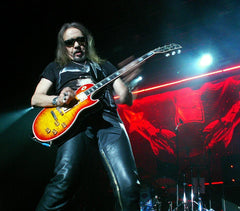In this article we take a close look inside every detail of RIAA "floater" awards, which were made from 1975-81. The purpose of this article is to help collectors of these awards know if a floater award they may be considering is authentic.
 1975-81 RIAA "floater" award
1975-81 RIAA "floater" award
This article reveals some very detailed information about the construction of the awards from these eras that we previously did not want to put out there.
Why? Because we don't want to arm those intent on making fake awards with any information that they use to create more authentic-looking fakes that could fool buyers. However, we notice that now some collectors have been putting many previously unknown details out on the Internet. These include fine details about frame profiles and corners, presentation plates, and so forth. Because of this we felt it was time that we should also arm our website visitors with this information.
Where does our information come from?
At MusicGoldmine.com we have done a great deal of work to learn every detail of all RIAA awards. We've examined and sold hundreds of awards. We've poured over information from every source available. And we've gathered information direct from many of those who actually made the awards.
This includes interviewing Ted Howell Jr., owner of the New York Frame & Picture Co. throughout the entire time that the company made RIAA awards, in 2019 before his death in 2021. His son (also named Ted Howell) worked in his father's shop helping make the awards from his early youth through his twenties and he has also been a great source of first-hand information.
Information about awards made by Creative Glassics has been gleaned through a variety of sources and by examining the awards made by that company. However, interviewing the owner of that company has proved elusive, perhaps due to the fact that the company ended its' RIAA award-making activity rather abruptly and amidst controversy after being sued by the RIAA. While the company initially had a license starting in the floater time period, by 1996 they were accused of making RIAA awards without a license. In 1998 the RIAA won a judgment against the company in an action which also barred them from making any future RIAA awards. Public records tell the tale:



So let's get started...
What Companies Made Floater Awards?
The only three companies that were licensed by the RIAA to make floater awards were the New York Frame & Picture Co. (NYF&P Co), Creative Glassics, based in New Jersey, and Al's Custom Frames & Gallery Ltd., the latter of which was based in Nashville and made, almost exclusively, only Country genre awards and ultimately very few awards versus the first two companies. For purposes of this article, we won't delve far into Al's Custom awards.
If still affixed, the awards should have one of the following labels on their backing paper. Note that by the floater era, all NYF&P Co labels should feature their post-1968 John St. address, not the Fulton St. address. The smaller NYF&P Co label with less text usually appeared only on single awards, but they can also appear on album awards, and vice versa with the larger label. Creative Glassics clearly moved many times and there are a multitude of addresses in New Jersey that appeared on their labels over time:


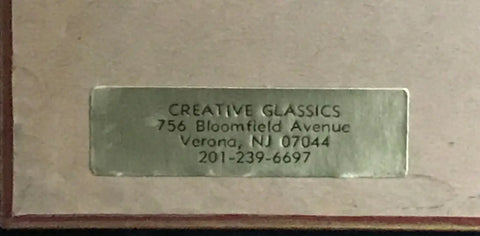

Placement of the stickers was also standard for each manufacturer. NYF&P Co centered their stickers in roughly the top third of the backing paper. Creative Glassics stickers placed them either on the bottom left or bottom right corner. Al's Custom stickers centered them just above the bottom rail.
Note also that there were at least two other companies that made floater style awards during this time period without a license from the RIAA, and a few record labels bought awards from those companies and gave them to their chosen recipients. We'll get into the awards from those companies later in this article but note that the "correct era/industry-genuine" awards made by these companies (which we call "grey area" awards) are not to be confused with awards that were created much more recently and designed to look like floater awards, but which were not used by the industry in any way.
The Basic Design Of RIAA Floaters
The design of RIAA floater awards was strictly controlled by the RIAA and, as mentioned, the only companies licensed to make them were NYF&P Co. and Creative Glassics. They all had to be the same size. Continuing on from the "white matte" award period, the album awards had to be 17.5" x 21.5" (44.5 cm x 54.6 cm) and single (45 rpm) awards had to be 13" x 17.25" (33 cm x 43.8).
Albums were certified Gold when the issuing record label could provide the RIAA with auditable sales data showing that they sold 500,000 copies, singles were certified Gold at one million copies sold.
The album versions had to be configured exactly as you see in the above Rolling Stones Love You Live example from 1977, and as you see here in an example of a single award for Earth, Wind & Fire's "September" from 1979:

In 1976, a year or so into the floater award era, the RIAA introduced its' Platinum certification program. Albums were certified Platinum when the issuing record label could provide the RIAA with auditable sales data showing that one million copies were sold. For singles to be certified Platinum, evidence had to be submitted proving two million copies sold.
Apart from silver painted frames and silver metal presentation plates instead of gold, the award designs were the same as the Gold awards. Here's an example of a Platinum single award, in fact the first single ever certified Platinum on April 20, 1976 for Johnnie Taylor's "Disco Lady":

Here's an example of a Platinum album award, this one from 1978 for Bob Welch's French Kiss album on which the late Christine McVie, who this award is presented to, appeared on the track "Sentimental Lady":

While the basic award designs were the same, there were some small differences in the awards made by the two different manufacturers which we'll cover below in the sections about the frames and presentation plates.
How Many Were Made Of Each Title?
A common question collectors ask is: How many were made of each? The RIAA has released no information on this so completely fact-based answers are hard to find. While in the RIAA 1964-74 "white matte" award era the number produced for each title is estimated to be between 5 and 25, the floater period saw higher numbers.
This was because many more people were given awards during this time, including more of those involved on the creative side, not just the artist. These creatives included songwriters and musicians, for example. Business recipients also increased to include more record executives, radio promoters, radio stations, and others. Regional offices of the record labels also received awards during this time, along with distribution arms of the labels. Here's an example of the latter -- a 1981 Platinum RIAA floater to Polygram Distribution, Inc. for Rush's 1976 album All The World's A Stage:

There is no doubt that the numbers of people who received awards for the most successful and popular artists exceeded those for less successful artists. However, outside of it being a higher number per title than the awards issued from 1964-74, only anecdotal evidence exists, and exact numbers are not known.
Award Presentation
Another common question is: Could anyone outside of the artist get awards in the artist's name? The evidence on this is fairly clearly yes. Ted Howell from NYF&P Co. indicated that the labels could order as many as they wanted in the artist's name and often did, because executives enjoyed the cachet of the artist's name on the plaque on their office wall.
Also, an artist had (and has currently today also) every right to order as many plaques as they want and gift them to whoever they chose, whether they be execs, roadies, friends, loved ones, or simply a friend.
There are also numerous examples of artists selling their own awards -- or one copy of their own awards since they may have multiples -- to raise money for charity or for other personal reasons. Bill Wyman of the Rolling Stones has sold his own awards and clearly has multiple copies presented to him. Known as an avid memorabilia collector himself, he also has or has had Charlie Watts- and Mick Taylor-presented awards he has sold through auctions.
Bernie Taupin sold all his awards in the last few years. Olivia Newton John put her awards up for sale to benefit charity prior to her untimely death, as did Fleetwood Mac's Christine McVie, and there are many other examples of this.
Artists have also been known to give their own awards away for a multitude of reasons from just needing money at some point in their careers or because they wanted to gift them to someone. In addition, it is very common for the estates of deceased artists to contain personal effects such as awards. We know because we have acquired awards in all of the above ways.
The bottom line is that there are many versions of how RIAA awards in an artist's name can land into the collector market.
Provenance
Regarding another separate issue: Does this mean that the artist's name on an RIAA award means that they ever owned or even touched it? Of course not. It does not necessarily prove this. That issue can only be resolved by evidence of provenance. Direct provenance is only occasionally available for older RIAA awards, unfortunately. If one has a bona fide letter of provenance from a family member or other trusted source, it is a wonderful thing, and the market value will clearly be higher.
For all the other awards that don't come with provenance, however, one must rely on whether they are constructed correctly, have correct certification, are appropriately aged, etc. as detailed in this article.
Frames
The Gold album and single awards had a gold painted wood frame, the Platinum album and single awards a silver painted frame. The frames were always nailed together on the outside of the corners. The nails were then inset, and the inset holes were filled with frame color-keyed wax. If these nail holes are not present on a floater, the award is not original from one of the RIAA-authorized companies.
While that detail was the same for both NYF&P and Creative Glassics, the profile of the frame differed for each manufacturer. While they both used a straight-edged frame from 1975 to mid-1977, the New York Frame & Picture Co. used a thicker height frame. Here is the profile of an '75 to mid-'77 NYF&P single award frame on the right versus a Creative Glassics on the left to illustrate this height difference. If you're curious, the NYF&P award is for Earth, Wind & Fire's "Shining Star", certified in 1975, while the CG award is for the Emotions "Best Of My Love", certified in 1977:

The early NYF&P frame measures 1-1/4" (32mm) high:

The Creative Glassics frame measures 1-1/16" (27mm) high:

Also, during this 1975 to mid-1977 period NYF&P (top) used no primer, while Creative Glassics (bottom) used a red primer, after using an orange primer and high gloss paint from 1975 to part of '76. The differences between no primer and red primer can be seen here on scratched frames of each. After mid-'77 both manufacturers used red primer:
After mid-1977 and through the end of the floater period to 1981, NYF&P switched to an angled profile frame, seen here next to a Creative Glassics frame, which stayed the same. Here are a few views of the two frames next to each other (NYF&P on right, CG on left in each photo):

Note the red primer showing through scratches on both:

Note here also the nails on each manufacturer's frame, filled with now very-aged wax. The top nail on the right (NYF&P) frame has worked its way loose and the wax is missing:

One more set of images here showing the different finishes close up. On the left is a Creative Glassics Platinum award frame. On the right is a post mid-'77 NYF&P Gold award frame:
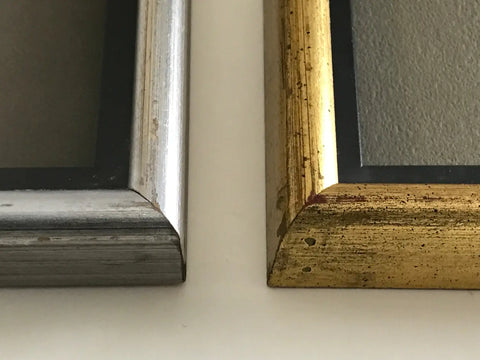

In terms of glass, while RIAA white matte awards had glass fronts, floaters featured plexiglass fronts, making for a lighter award and less breakage during shipping.
Matte
This was an area of consistency between the two manufacturers. A charcoal-colored pebble matte was used. The pebble texture is quite pronounced, and this is a key attribute of an original floater award matte.
Here's a close up showing the distinctive pebble texture. It also shows the stark difference between the original matte color and the faded color that results from light exposure over time. This is an award on which the album miniature has fallen off, and you are also seeing the edge which the frame spacer has covered and thus protected from the light over the years:
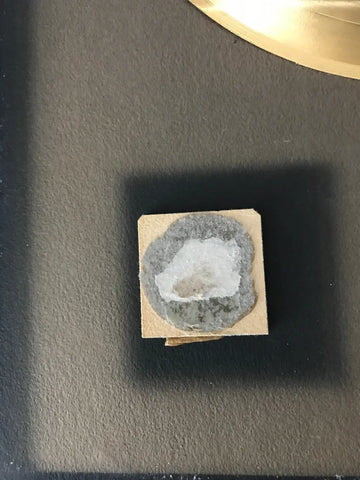
The other detail you can see here is the mounting area on which a block of cardboard sat, which "floated" the album miniature above the matte, giving these awards their nickname. The metal presentation plate and metal mother record disc were also floated on cardboard blocks.
Album Miniature
As shown in the photo above with it removed, the album miniature was approx. 3-1/4" to 3-1/2" (8.26 to 8.89 cm) square and mounted on a small cardboard spacer. Most floaters exposed to any type of light over time see fading of the miniature. Usually this correlates to the amount of fading of the matte but it is notable that most of the black tones seem to wash out to a more brownish appearance. Here's an example of minimal fading (top) versus more significant fading (bottom):


Just as with any vintage award in terms of ascertaining authenticity, checking that the album miniature appears exactly as the album was originally released in the year of the award is a good idea. i.e. It cannot be a reissue album cover.
Record Disc
All floater awards created by these two main companies featured metal mother discs, not plastic. They are actually made of nickel and are quite thin, which can be seen when viewed from the side, and can also at times appear slightly warped. These metal discs also make the awards feel heavier than later RIAA era awards. Some of the discs used by NYF&P were made by Disc Award Ltd., as are more often seen in white matte era awards, like this example for a Captain & Tennille award from 1976. However, most discs were not made by this manufacturer and have no branding or meaningful markings in their dead wax area:


It's also worth noting that the number of bands of tracks on the record typically bears no relation to the actual number of tracks on the record certified. There are rare exceptions to this (such as most Bruce Springsteen awards due to his insistence that his records be used in most of his awards).
Here's what the back of one of these metal mother discs looks like and note the four blobs of adhesive. Ted Howell of NYF&P Co. said that, in the early days of production on floater awards, with the adhesive they originally used many of the metal discs became dislodged during shipping. That is until they discovered what he called "Miracle Black Cement," which is the adhesive you see here:

You can detect if an award has the metal master disc by closely inspecting the side of it when viewed low down to the matte. The edge of the record should be very thin. If you see a thick edge, it is a plastic disc and the award is not authentic, or at least one made by NYF&P, Creative Glassics, or Al's Custom Frames & Gallery Ltd., the only three RIAA-licensed manufacturers of floaters (more on this later in this article as mentioned above).
You can see this in the following two photos. Also note that for Platinum awards, the discs were left as is. For Gold awards, the metal discs were coated with a very thin layer of gold and you can at times see slight degradation of this thin layer when you view the edge of a gold plated metal master disc, such as the gold disc photo below shows.
Here is a Platinum award disc on a floater award viewed from the edge, showing how thin it is (for reference, this is a 1977 award made by Creative Glassics for the Emotions album Rejoice):

Here is a Gold award disc on a floater award viewed from the edge, showing how thin it is and also the slight degradation of the the gold plating that can at times be seen (for reference, this is a 1976 award made by NYF&P for the Parliament Funkadelic album Mothership Connection)

Presentation Plate
Presentation plates on floaters are made of brushed steel and are mounted on cardboard blocks so as to float above the surface of the matte.
The plate designs were mandated by the RIAA to feature the same classic RIAA logo used from 1964 through 1985 on white matte awards ('65-'74), then floaters, and it was also used on 1982-85 "strip plate" awards. The logo was designed to represent a stylus with its' needle in the grooves of a record:
On white mattes the logo was acid-etched onto the presentation plates giving its edges a slightly raised appearance. While the logo itself didn't change for floaters, it was printed onto the presentation plates differently. Technically called sublimation printing, the process transfers special dyes via heat and pressure onto the surface of the metal plate. The result is flatter appearing than on the plates used on white matte awards.
Interestingly, and probably due to relatively crude graphic arts and printing processes in the 70s and 80s, the logo on NYF&P award and Creative Glassics awards is slightly different. Here is the NYF&P plate on top, with the CG below:


Can you spot the difference in the RIAA logo between the NYF&P and Creative Glassics plates? While there are seven "grooves" in the record on each logo, the logo Creative Glassics used has an extra top, or "shelf," on the left and right end grooves, whereas NYF&P does not.
These photos also show the plate used on a Gold award versus a Platinum, and to an extent the most dramatic difference is the slight font variation between the two.
However, in terms of the variation in the RIAA logo, here are close ups of the two (NYF&P on top, Creative Glassics on bottom) with the difference on the Creative Glassics version indicated:


Speaking of the font difference between the two manufacturers, this would become quite pronounced at times and varied over time. While the "presented to" and recording information has a different font and/or ages differently from the award level information, it was typically consistent.
However, the recipient's name and record information font sometimes varied. This is because the award level info is pre-printed on the plates and the recipient/recording information is added when the award is made. Ted Howell of NYF&P commented that they used different trophy shops to engrave this latter information, which is the reason why this occurred.
In fact, some markedly different fonts can be seen on floaters. Here's an example on a 1979 Journey award for their album Evolution on a floater made by Creative Glassics that shows markedly different plate fonts:


Finally, as you can see from the above examples, the language on the plates changed from that used during the previous white matte RIAA award period. To reflect changing consumer record buying habits the RIAA changed the way sales were described and the language used on floater awards to the following:
For Gold LPs/albums 1975-81:
PRESENTED TO
[award recipient]
TO COMMEMORATE THE SALE OF MORE THAN 500,000 COPIES OF THE
[XXX record label]
LONG-PLAYING RECORD ALBUM
[album title]
(Note that the LP language would change on post-1975 awards).
For Gold 45s/Singles 1975-81
PRESENTED TO
[award recipient]
TO COMMEMORATE THE SALE OF MORE THAN ONE MILLION COPIES OF THE
[XXX record label]
SINGLE RECORD
["song title"]
For Platinum LPs/albums 1976-81 (the Platinum program started in 1976)
PRESENTED TO
[award recipient]
TO COMMEMORATE THE SALE OF MORE THAN 1,000,000 COPIES OF THE
[XXX record label]
LONG-PLAYING RECORD ALBUM
[album title]
(Note that the LP language would change on post-1975 awards).
For Platinum 45s/Singles 1976-81
PRESENTED TO
[award recipient]
TO COMMEMORATE THE SALE OF MORE THAN TWO MILLION COPIES OF THE
[XXX record label]
SINGLE RECORD
["song title"]
It's notable that you will occasionally see inaccuracies on the RIAA website when the number of units sold is listed for a certified recording during some of these time periods since the standard changed several times through the 70s and 80s.
"Grey area" floater awards made by manufacturers with no official RIAA license: Now that we've covered all the details of what a collector should see from floater awards made by the two main RIAA-licensed manufacturers, let's explore what we call "grey area" awards.
This is an interesting topic and not one without controversy among collectors and the two officially RIAA-licensed companies who made awards. What is certainly a fact is that neither we, nor anyone else, has come forward publicly with any evidence to definitively prove that any company or individual produced awards without a RIAA license (except when Creative Glassics themselves did this in the 90s as detailed in the legal case mentioned above), or that any record label or other music industry entity ordered or purchased them from any manufacturer without that license.
With that disclaimer out of the way, we can discuss what some collectors believe and look at some of the facts surrounding this topic.
While the music business has always been full of characters, both on the creative and business side, the 60s through 80s were really the "wild west" days of the industry. Huge profits were made as record sales soared and many people, individual entrepreneurs often, started successful labels, managed artists, promoted concerts, programmed radio stations and so on. It was not the corporatized global business that the industry is today. For a peek inside what it was like, Fredric Dannen's 1991 book Hit Men is a good read and fascinating inside look at what the industry was like [Editor's note: No, he's not a relative of anyone at MusicGoldmine.com...].
The record award manufacturing business was no different. As the record business thrived, and labels wanted to reward more and more industry people with record awards, new manufacturers jumped in to meet the need. Also, as expected, some did it for a lower price than the three RIAA-licensed manufacturers, who had each paid hefty fees to the RIAA for the rights to produce the awards.
As mentioned above when chronicling the various award manufacturers over time, by the mid-70s the New York Frame & Picture Co. was no longer the only provider, as Creative Glassics became the second license holder, followed shortly after by Al's Custom Frames & Gallery Ltd. What is clear is that these companies were in competition with one another at that point, fighting for all the record labels' business.
And clearly at some point, some labels—no one knows with any certainty which — acquired awards from some other individuals or companies who made awards — again, no one knows with any certainty which — who had no RIAA license. We'll never know this with any certainty because the RIAA makes no records available about the awards made. The only thing publicly available are certification dates for releases that appear on their website.
One theory goes like this: Fitzgerald-Hartley officially became an official award maker after NYF&P Co. and Creative Glassics did, sometime in the mid-80s. While we have not seen definitive proof of this, word is that a former Fitzgerald-Hartley employee involved in making their awards was the one who started creating floater style awards after leaving the company. They did this without being granted a license by the RIAA.
Whoever it was, while not obtaining a RIAA license they clearly had some record label connections who bought these floater-style awards from them during the time period of 1981-85.
Note that this was after the RIAA specified in 1982 that "strip plate" style awards were to be issued from that point forward, until 1985, after which "flower hologram" style awards were specified by the RIAA as the new design. This is why it is possible to find floater-style awards on releases that were certified to Gold or Platinum after 1981 and until around 1985.
While we have seen and examined awards made in the floater style from this time period, the vast majority do not have any manufacturer sticker on their backing papers. In terms of construction they also had glued frames, not the nailed together frames that Creative Glassics and the New York Frame & Picture Co. used. We have seen very few examples of these awards like the Prince Purple Rain "floater" style award pictured below.
The examples we have seen, and that includes awards that are clearly appropriately aged and presented to verifiable industry figures, have had no sticker on what appear to be original backing papers. While this supports the theory that they may have been made by a company or individual without a license, it is notable that this does not prove who made them, regardless of what popular lore is out there among collectors.
Whatever their origin, these awards are made to almost the exact same standards as floater awards of the era. Notable differences are that vinyl records were used with a "gold" or "platinum" metal coating applied under a process newly developed around that time. This process was used in all later awards as metal master discs ceased being used in awards from around the mid-to-late 1980s. (Recall however that neither NYF&P nor Creative Glassics ever made any floater awards without metal master discs in them and NYF&P never made any awards with plastic discs).
At times different fonts also appeared on the presentation plates and frame materials varied on these awards. All this notwithstanding, these pieces -- as long as they can be traced to the 80s and are not reproductions made more recently -- still make for great collector's items from the time period.
Here is an example of one of these awards (front and back), this one issued around 1984 for Prince's Purple Rain album going Platinum. This award had impeccable provenance (we have a notarized letter of provenance for this award), having been given by Prince's bodyguard at the time Chick "Big Chick" Huntsberry, who also appeared as himself in the Purple Rain film, to his attorney.


As other examples of these “grey area” awards, here are details regarding various Van Halen awards that have no manufacturer labels and, like the Prince example above, the story involves awards issued for records released by Warner Bros. Records.
These awards are definitely originals from the 1980s, backing papers and all. They came from a former executive at Warner Bros. who got them from a colleague who was then the Sr. VP of Publicity at Warner Bros. Typically, no one makes fake awards presented to an unknown executive and, more to the point, we also have in our possession a letter of provenance from the Warner Bros. executive for these awards as well. These are real awards from the 1980s time period. So why no manufacturer label if they were made by a RIAA-licensed maker? We'll never know for sure, but it is most likely that they were made by an unlicensed manufacturer.
Here's the front and back of these example awards related to Van Halen's 1984 album. Note the alternate font on the presentation plate, and also that the RIAA "Strip Plate" design was supposed to be utilized in all RIAA awards produced at that time in 1984:


Here's one for Van Halen's 1984 single "Jump" which holds another clue that this was likely made by an un-licensed manufacturer: It is constructed in a different size than the RIAA had mandated for single floater-era awards. It is 10" x 14" instead of the standard 13" x 17". Also, note again the alternate font on and floater design presentation plate at a time when the "Strip Plate" design was mandated by the RIAA:


Here's a final example, also from what was supposed to be the 1982-85 "Strip Plate" period. While Aldo Nova's 1982 self-titled album was certified Gold on May 14, 1982 by the RIAA, and the recipient is a verified record label executive--Ron McCarrell, who was VP of marketing for Epic/Portrait/CBS Associated Labels at the time--the record award was not made by a RIAA-licensed manufacturer. Instead, it was made by Starship, a company that was based in Brooklyn Heights, New York. The company made the award in the floater style, although there are some differences that make it non-standard.
Even a not-so-close examination shows numerous anomalies versus a RIAA-licensed manufacturer floater awards: It has as a velvet matte (versus the charcoal-colored pebble texture matte), non-standard printing on the presentation plate, and different spacing of the album miniature and plate.

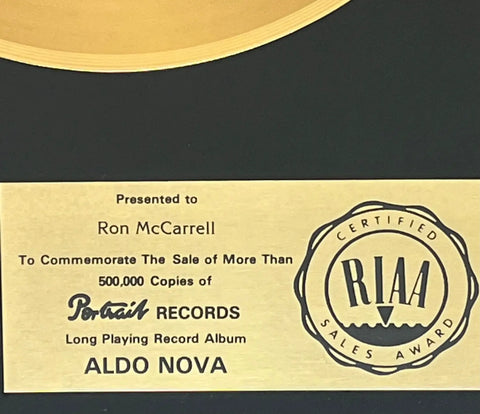

So, do these examples with construction anomalies and lack of officially-RIAA licensed manufacturer stickers make these awards "fakes?"
No, at least not in the context of "are they genuine music memorabilia?" They are, in fact, genuine artifacts of the era, created and given to verified record executives and others to recognize the achievements of the artists and their records. However, by all examination of the evidence they are also certainly, or in some cases probably, not awards manufactured under license of the RIAA.
Sure, in the eyes of a RIAA-licensed award manufacturer they are no doubt referred to as "fakes." However, in the eyes of a collector they should be viewed as bona fide pieces of music memorabilia. They were owned by people in the industry, they are of the era, and they are typically very similar if not precisely similar to the awards made by the licensed manufacturers. And it’s certainly possible that the theory that they were manufactured by a “soon to be licensed” RIAA award maker is true.
In reality, the only collectors who would object to making these a part of their collection is the one who is such a purist that they want to own only "officially licensed RIAA manufacturer" awards.
Aging, Aging, Aging
Here's a factor that applies to all awards, whether it appears to be from a RIAA-authorized manufacturer or not. Simply put, does the award you are considering look 35-40 years old? If not, it probably isn't since we'll remind again that floater awards were only produced (officially) from 1975-81, while "grey area" examples can be seen only for records into the mid-80s.
A Final Word
While examining any RIAA floater award, remember to assess it based on all the criteria above, not any one factor. You should always also check the RIAA certification of an award you are considering to determine the date it was certified to see if it makes sense. You can do this simply by searching at https://www.riaa.com/gold-platinum/
Also remember that each floater award was made in a workshop in the 1970s or early 1980s by craftsmen without computerized equipment. These are handcrafted items and slight variation can occur both in terms of the materials and the construction of these awards.
Here's a closing image showing NYF&P Co. workers proudly displaying a pile of floater awards they just made for ELO's 1975 album Eldorado. Note the fresh charcoal-colored mattes with their rich dark color still intact:
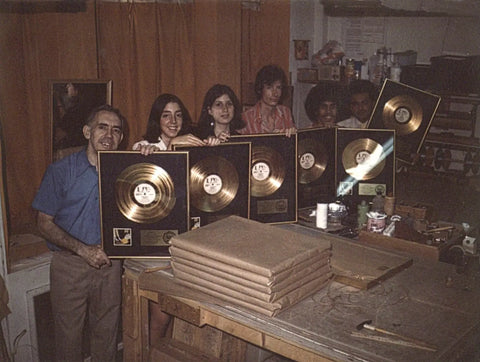
New York Frame & Picture Co. staff posing with freshly made RIAA awards, circa 1975 (Photo courtesy Ted Howell. Used with permission)
Good luck in your collecting, whether it be RIAA floaters or other awards!
See our current selection of RIAA awards here.
Feel free to share this article, but please only share in its entirety and leave all hyperlinks intact and active for copyright and credit reasons. All photos copyright MusicGoldmine.com. Photos of all awards and award details in this article are of awards that we have personally held in our hands.
Want more content like this? Sign up for our free MusicGoldmine.com newsletter here.
Important Notice/Disclaimer: While many record awards and music memorabilia items appreciate in value, others fall in value and MusicGoldmine.com makes no claims, express or implied, that any item will appreciate in value at any time in the future. Further, MusicGoldmine.com is not providing investment advice in any of its' content.



